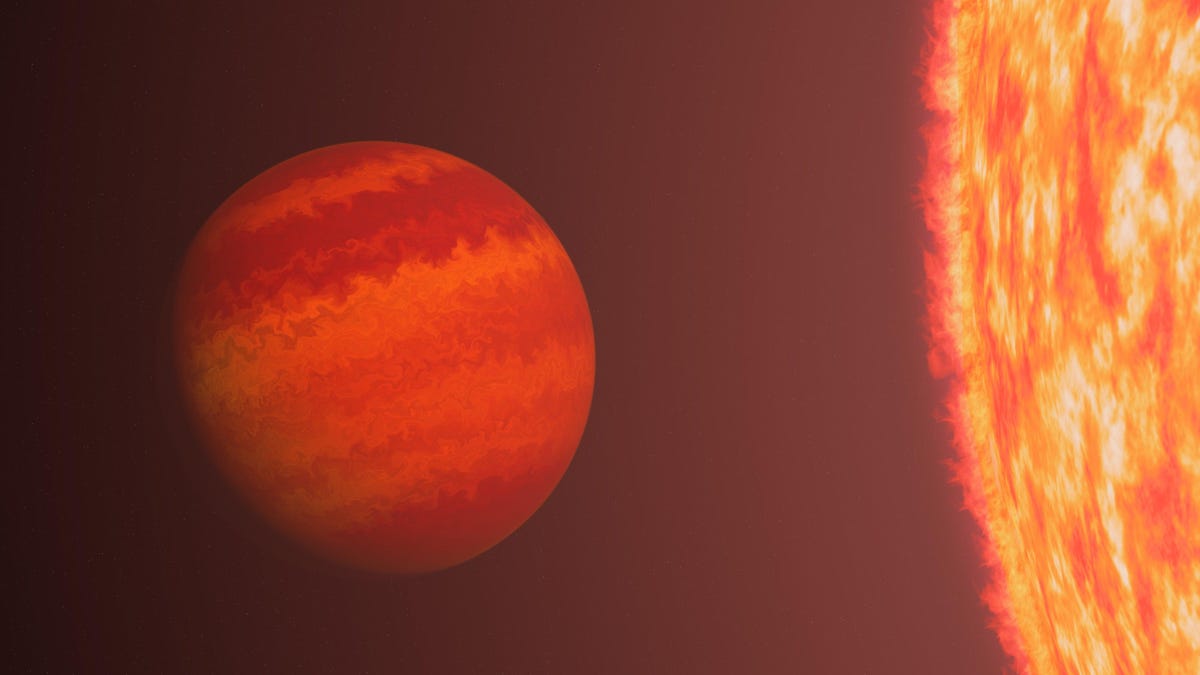
In his search for giant stars hosting large worlds, Samuel Grunblatt, an astrophysicist at Johns Hopkins University, came across a strangely puffy planet that’s smaller, hotter, and older than it’s supposed to be. “We didn’t expect to find any planet that looks like this,” he told Gizmodo.
The newly discovered planet had somehow persevered against its host star’s intense radiation, growing a puffy atmosphere rather than being stripped down to its core from being so close to such a large star. The discovery suggests that Earth and the rest of the planets in our solar system may evolve differently as the Sun becomes a dying star. The new findings are detailed in a study published Wednesday in The Astronomical Journal.
Advertisement
TIC365102760 b, also known as the Phoenix, defies theories of how planets die. The exoplanet is classified as a hot Neptune, with its size being somewhere in between Neptune and Saturn. Due to its proximity to its host star, however, the exoplanet has scorching hot temperatures as opposed to the icy conditions of Neptune. The Phoenix completes an orbit around its host star every 4.2 days, and is about six times closer to its star than Mercury is to the Sun. Its star is about three times larger in radius than our host star, causing temperatures on the exoplanet to reach 1,600 degrees Kelvin.
Orbiting this close to a massive star should have fried the exoplanet already, but this big boy is here to stay. “Finding a planet that actually was kind of Neptune-sized at such an intense environment was was quite a surprise,” Grunblatt, lead author of the study, said. “So then, our question became, how did this planet actually hold on to its atmosphere? And that’s something that we’re still working on.”
Advertisement
Using data from NASA’s Transiting Exoplanet Survey Satellite (TESS), the scientists behind the new study developed their own pipeline for spotting giant stars. TESS is good at spotting low-density planets as they transit in front of their host stars in orbit, dimming the brightness of the stars. The team filtered out unwanted light in images obtained by TESS and combined them with additional measurements from the W.M. Keck Observatory in Hawaii, which tracks the tiny wobbles of stars caused by orbiting planets. By doing so, the researchers found a number of examples of giant star systems with large planets in their orbit.
The scientists behind the new study believe that the exoplanet’s atmosphere was smaller when its host star was more Sun-like. As it aged, however, and transformed into a red giant star, the subsequent radiation may have caused the planet’s atmosphere to expand without having been totally lost at that point.
Advertisement
Our own Sun will approach its red giant phase some 6 billion years from now, running out of fuel and causing its core to contract. As it approaches death, the Sun will expand and engulf the inner planets of the solar system in the process (including Earth). This theory suggests that radiation from the dying Sun will have stripped Earth of its atmosphere long before it gets swallowed up by its host star. The new discovery, however, suggests an alternative ending.
“What this is telling us is that, actually, the atmosphere might last until that final stage where the planet is actually inside the star,” Grunblatt said. “That also has implications for all of the evolutionary steps leading up to that.” For example, the presence of Earth’s atmosphere determines when water would permanently evaporate from all of the planet’s oceans. It also determines how long life can survive on Earth as the Sun reaches its final stages.
Advertisement
The puffy exoplanet is one of a series of a “giants transiting giants” series whereby the researchers focus on finding exoplanets orbiting large stars. “We’re hoping that, by getting a larger population of giants transiting giants, then we’ll be able to…understand the evolution of the solar system overall.”
The team has applied to run follow-up observations of the newly discovered exoplanet using the Webb Space Telescope to be able to study its composition and retrace its history.
Advertisement
More: Spock’s Home Planet Never Really Existed
Services Marketplace – Listings, Bookings & Reviews